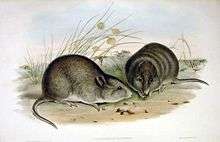Broad-faced potoroo
| Broad-faced potoroo[1] Temporal range: Recent | |
|---|---|
 | |
| Scientific classification | |
| Kingdom: | Animalia |
| Phylum: | Chordata |
| Class: | Mammalia |
| Infraclass: | Marsupialia |
| Order: | Diprotodontia |
| Family: | Potoroidae |
| Genus: | Potorous |
| Species: | P. platyops |
| Binomial name | |
| Potorous platyops Gould, 1844 | |
The broad-faced potoroo (Potorous platyops) is an extinct species of marsupial that once lived in Australia. The first specimen was collected in 1839 and described by John Gould in 1844, but even then it was rare and only a handful of specimens were ever collected, the last in 1875. Subfossil remains indicate that it originally had an extensive distribution from the semiarid coastal districts of South Australia to the Western Australian coast, and possibly as far north as North West Cape.
The habits of the broad-faced potoroo are almost entirely unknown. It clearly avoided the fertile forested areas that its relatives the long-nosed and long-footed potoroos inhabit. It is unusual amongst recently extinct Australian vertebrates in that it appears to have declined significantly before the European settlement of Australia.
Preserved specimens indicate that it was smaller than the other potoroos at around 24 cm long with an 18-cm tail. The coat was grizzled grey above and dirty white below, the body similar in shape to that of a large rat. The ears were small and rounded, the muzzle was fairly short, and the cheeks were notably puffy.
References
- ↑ Groves, C.P. (2005). Wilson, D.E.; Reeder, D.M., eds. Mammal Species of the World: A Taxonomic and Geographic Reference (3rd ed.). Baltimore: Johns Hopkins University Press. p. 58. OCLC 62265494. ISBN 0-801-88221-4.
- ↑ Australasian Mammal Assessment Workshop (2008). "Potorous platyops". IUCN Red List of Threatened Species. Version 2008. International Union for Conservation of Nature. Retrieved 29 December 2008. Database entry includes justification for why this species is listed as extinct
